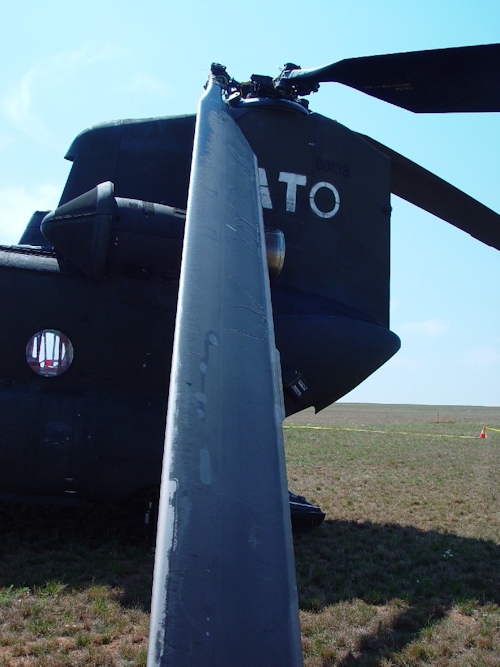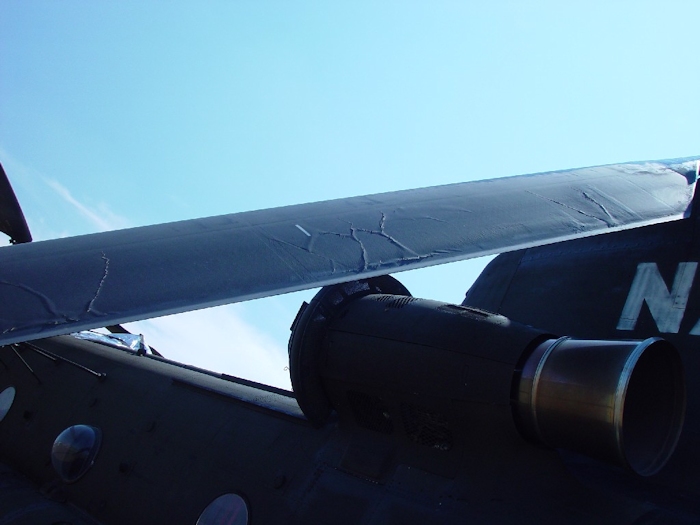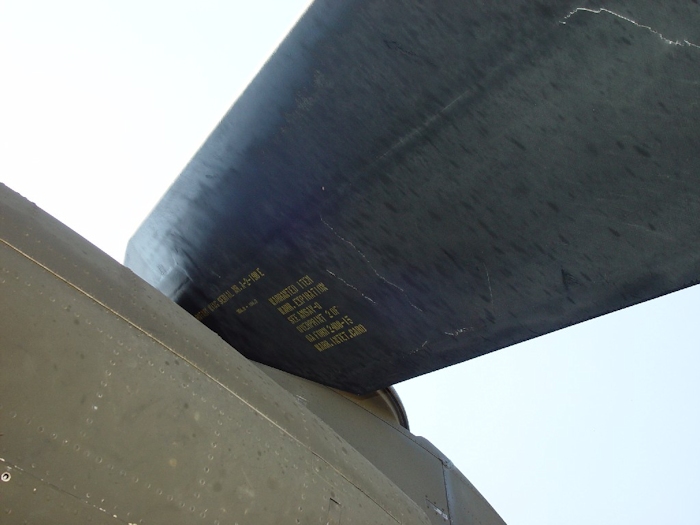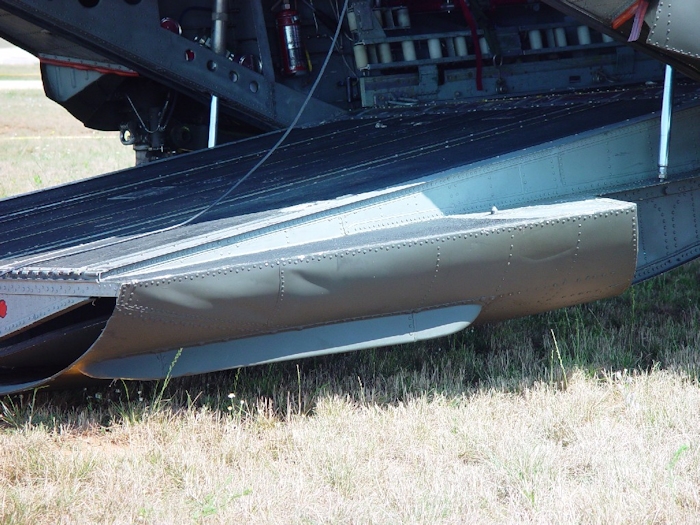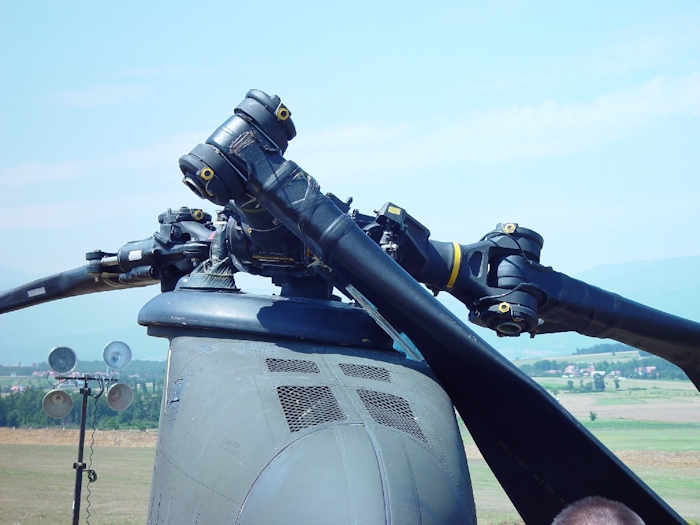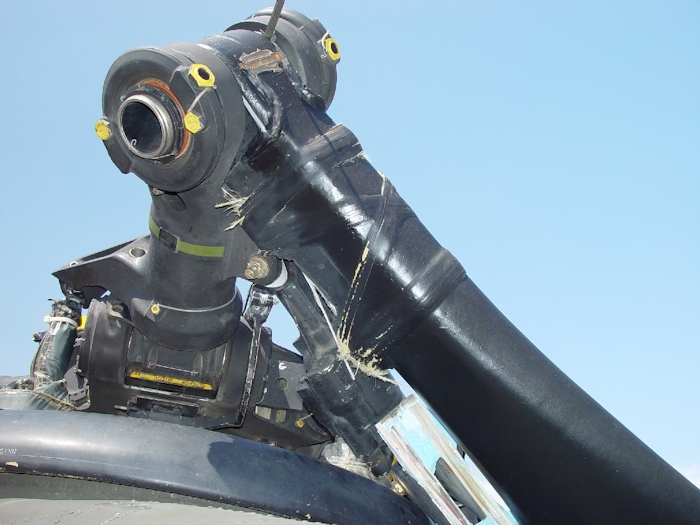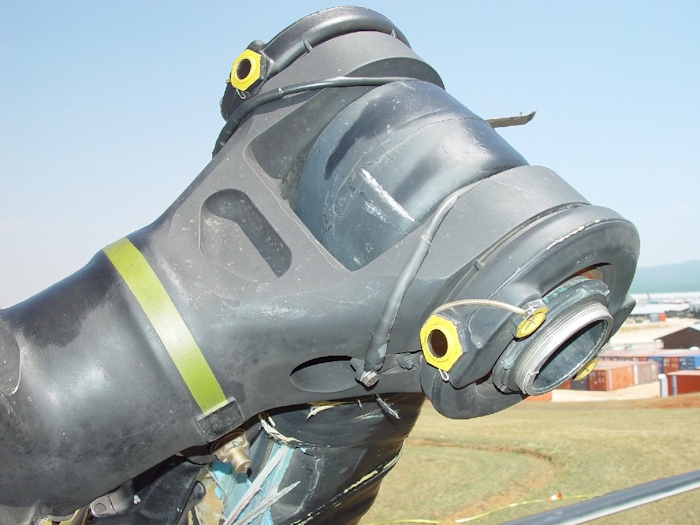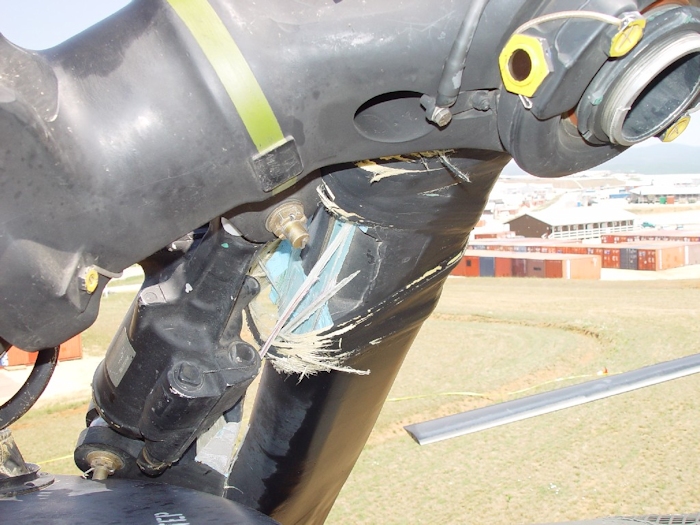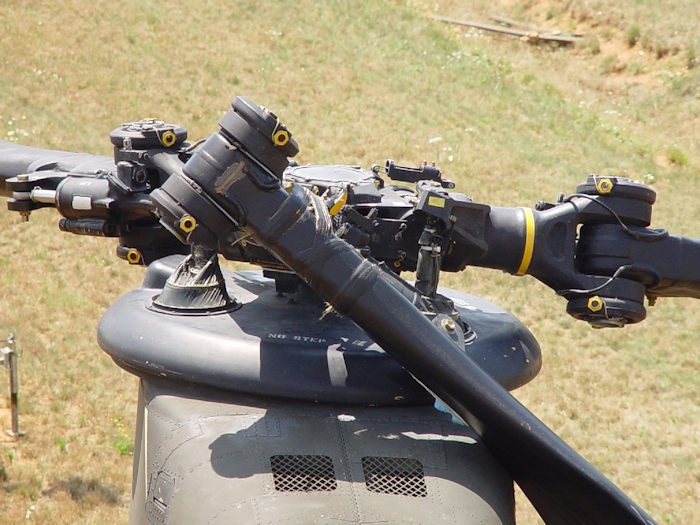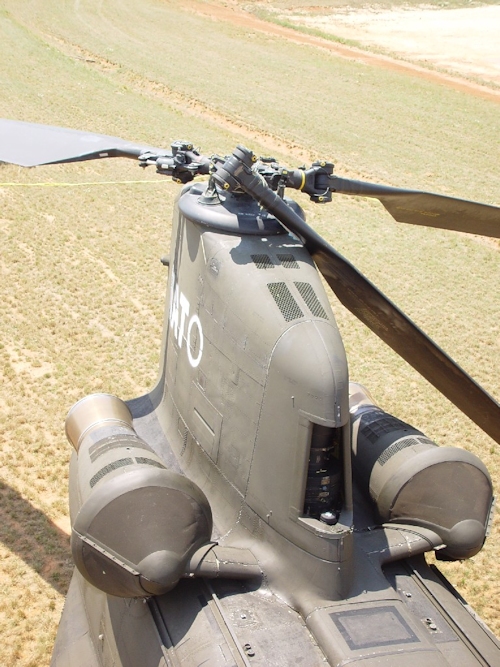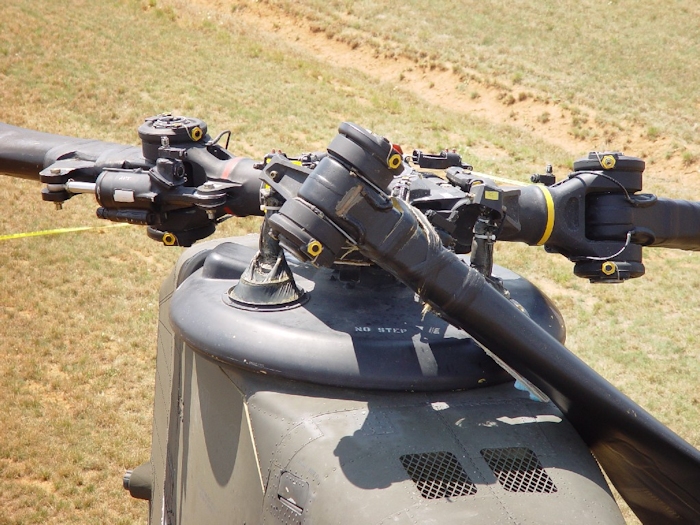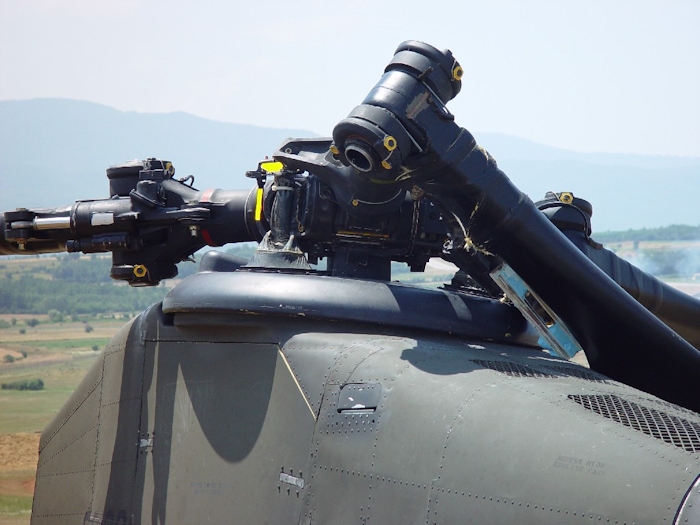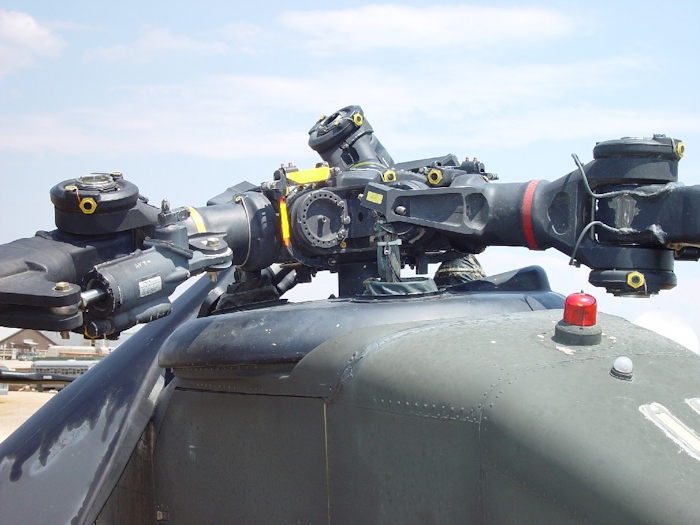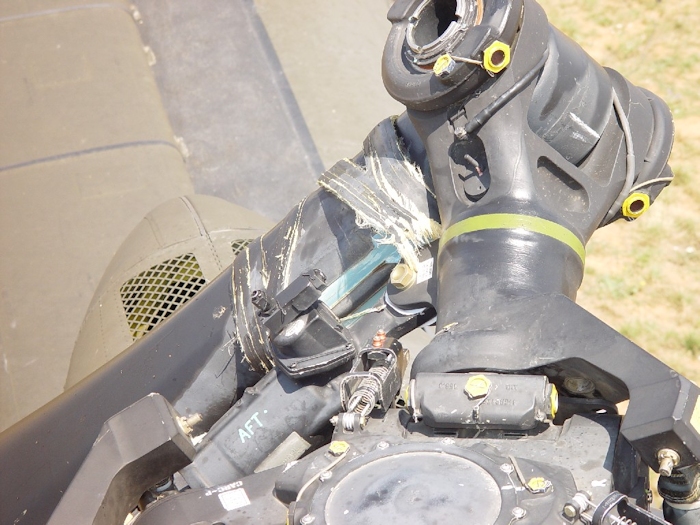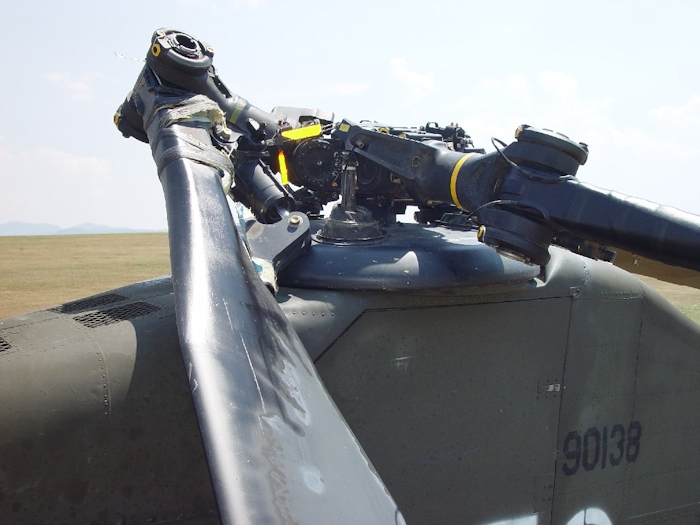| Camp Bondsteel, Serbia, Accident Photographs |
| The Day After |
|
| July 2002: Sitting in the grass at Camp Bondsteel, Serbia, this photograph shows 89-00138 the day after the accident. An aft rotor system blade lead-lag dampner lug has broken off allowing the blade to droop excessively low where it came in to contact with the fuselage and damaged the structure. Click-N-Go Here to view a larger version of this image. |
|
| July 2002: This photograph shows extensive damage to an aft rotor blade. There are cracks and tears in the structure of the blade. Click-N-Go Here to view a larger version of this image. |
|
| July 2002: This photograph shows extensive damage to an aft rotor blade. There are cracks and tears in the structure of the blade. Click-N-Go Here to view a larger version of this image. |
|
| July 2002: This photograph shows extensive damage to an aft rotor blade. There are cracks and tears in the structure of the blade. Click-N-Go Here to view a larger version of this image. |
|
| July 2002: This photograph shows some damage to the skin on the right side of the ramp. It is unknown if this was accident related. Click-N-Go Here to view a larger version of this image. |
|
| July 2002: This photograph shows extensive damage to the aft rotor system. A lead-lag dampner has broken off allowing the green blade to strike the fuselage and ground. All blades on a Chinook rotor system are color coded - Red, Green, or Yellow. Look for the paint stripe on the rotor head - the yellow stripe is easily visible. Click-N-Go Here to view a larger version of this image. |
|
| July 2002: This photograph shows extensive damage to the aft rotor system. A lead-lag dampner has broken off allowing the green blade to strike the fuselage and ground. All blades on a Chinook rotor system are color coded - Red, Green, or Yellow. Look for the paint stripe on the rotor head - the green stripe is easily visible. Click-N-Go Here to view a larger version of this image. |
|
| July 2002: This photograph shows extensive damage to the aft rotor system. A lead-lag dampner has broken off allowing the green blade to strike the fuselage and ground. All blades on a Chinook rotor system are color coded - Red, Green, or Yellow. Look for the paint stripe on the rotor head - the green stripe is easily visible. Click-N-Go Here to view a larger version of this image. |
|
| July 2002: This photograph shows extensive damage to the aft rotor system. A lead-lag dampner has broken off allowing the green blade to strike the fuselage and ground. All blades on a Chinook rotor system are color coded - Red, Green, or Yellow. Look for the paint stripe on the rotor head - the green stripe is easily visible. Click-N-Go Here to view a larger version of this image. |
|
| July 2002: This photograph shows extensive damage to the aft rotor system. A lead-lag dampner has broken off allowing the green blade to strike the fuselage and ground. A mount bolt from the dampner has punctured a hole in the rainshield. Click-N-Go Here to view a larger version of this image. |
|
| July 2002: The interposer block - the retangular piece of steel well below the yellow painted area - that would normally rest against the droop stop (the yellow painted hardware) and the rotor head hub, failed to engage during the accident sequence. When this happens, the aft rotor blades will droop down and make contact with the fuselage. Click-N-Go Here to view a larger version of this image. |
|
| July 2002: Without the droop stops engaged and the dampner firmly attached, an aft rotor blade will make contact with the fuselage during engine shutdown and cause extensive damage. Click-N-Go Here to view a larger version of this image. |
|
| July 2002: Without the droop stops engaged and the dampner firmly attached, an aft rotor blade will make contact with the fuselage during engine shutdown and cause extensive damage. Click-N-Go Here to view a larger version of this image. |
|
| July 2002: Without the droop stops engaged and the dampner firmly attached, an aft rotor blade will make contact with the fuselage during engine shutdown and cause extensive damage. Click-N-Go Here to view a larger version of this image. |
|
| July 2002: Without the droop stops engaged and the dampner firmly attached, an aft rotor blade will make contact with the fuselage during engine shutdown and cause extensive damage. Click-N-Go Here to view a larger version of this image. |
|
| July 2002: Without the droop stops engaged and the dampner firmly attached, an aft rotor blade will make contact with the fuselage during engine shutdown and cause extensive damage. Click-N-Go Here to view a larger version of this image. |
|
| July 2002: Without the droop stops engaged and the dampner firmly attached, an aft rotor blade will make contact with the fuselage during engine shutdown and cause extensive damage. Click-N-Go Here to view a larger version of this image. |
|
| July 2002: Without the droop stops engaged and the dampner firmly attached, an aft rotor blade will make contact with the fuselage during engine shutdown and cause extensive damage. Click-N-Go Here to view a larger version of this image. |
|
| July 2002: A view of the top of the aft end of the aft pylon for those who have never seen it. Located here is the top Anti-Collision Light (red) and the two aft pylon Formation lights (they glow pale green at night and allow other aircraft in your formation to see you). Combined with the three Formation light mounted up forward on the top of the aircraft, all five Formation Lights form an arrow pointing in the direction the aircraft is travelling. The white colored light in between the anti-collision and formation lights is an infra-red formation light that can only be seen using Night Vision Goggles. Click-N-Go Here to view a larger version of this image. |
|
| July 2002: Without the droop stops engaged and the dampner firmly attached, an aft rotor blade will make contact with the fuselage during engine shutdown and cause extensive damage. It will also eventually make contact with the ground. Click-N-Go Here to view a larger version of this image. |
|
| July 2002: Without the droop stops engaged and the dampner firmly attached, an aft rotor blade will make contact with the fuselage during engine shutdown and cause extensive damage. It will also eventually make contact with the ground. Click-N-Go Here to view a larger version of this image. |
|
| July 2002: Without the droop stops engaged and the dampner firmly attached, an aft rotor blade will make contact with the fuselage during engine shutdown and cause extensive damage. Here one can see the Kevlar Windings that are wrapped around the blade and dampner lug mount - they are now broken. Thousands and thousands of wraps of hair thin strands normally attach the two items together creating an extremely strong bond capable of withstanding the extreme loads imposed during flight operations. Click-N-Go Here to view a larger version of this image. |
Read more, just Click-N-Go to the next page: 1 2 3 4 5 6 7 8 9 10 |
| Click-N-Go Here to return to the main page for 89-00138. |
| Related Information |
| Explore the Chinook helicopter |
 |
|
| Comments or Questions ? |  |
Email the Webmaster. |
|
|
